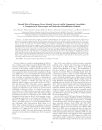Natural diet of European green lizards, Lacerta viridis (Squamata: Lacertidae): A comparison of macroscopic and molecular identification methods 2023
- Autoři
- Domagoj Gajski, prof. Mgr. Stanislav Pekár, Ph.D.
- Abstrakt
An analysis of the diets of reptiles is essential for understanding the role of reptiles in the ecosystem and the employment of successful conservation management plans. For this purpose, noninvasive and invasive methods to identify consumed prey have been used. Here, we investigated the diet of male and female European Green Lizards (Lacerta viridis) by sampling fecal pellets across 2 yr in the spring and late summer at a single site. We used the following two methods for identifying prey remnants from fecal samples: the classical macroscopic approach that requires competent expert knowledge and the molecular approach based on the dietary metabarcoding of nondegraded prey remnant DNA. According to both methods, lizards consumed mainly insects belonging to 13 orders, with Coleoptera as the dominant prey. The number of prey taxa was similar between the sexes, but the prey composition at the genus level was significantly different, with males capturing some coleopterans more than females. The diets also differed significantly between season. In the spring, lizards consumed many more prey types and many more coleopteran specimens than in late summer. The proportion of identified prey taxa was significantly different between the identification methods. From the total of identified prey, macroscopic identification yielded only about 50% of taxa, whereas molecular identification yielded more than 80% of taxa. Our results show that molecular identification can recover a much higher number of prey than the macroscopic method, yet not all prey. Thus, the integration of both methods best described the natural diet and complex trophic interactions of European Green Lizards.
Association between arthropod densities suggests dominance of top-down control of predator-prey food-webs on pear trees during winter. 2022
- Autoři
- Domagoj Gajski, Ing. Ondřej Košulič, Ph.D., Mgr. Radek Michalko, Ph.D., prof. Mgr. Stanislav Pekár, Ph.D.
- Abstrakt
Although winter in the temperate zone is considered to be the period of arthropod quiescence, some pests and their natural enemies remain active and interact in simplified food-webs. Limited information exists about the relative importance of top-down and bottom-up processes regulating arthropod food-webs and their spatio-temporal dynamics during winter. This information is essential for the development of effective conservation biocontrol methods. We investigated how the pest management of pear orchards (integrated [IPM] vs organic) and tree location within orchards (margin vs centre) influence the association between densities of winter-active spiders, insect herbivores and winter-inactive predators (spiders, insects) from October to April. We installed carboard bands on trunks and branches of pear trees in four organic and four IPM orchards to collect bark-dwelling arthropods. We then modelled relationships between the densities of four functional arthropod groups, namely winter-active spiders, winter-inactive spiders, winter-inactive insect predators, and herbivores. In early winter, we found a hump-shaped relationship between the densities of winter-active spiders and herbivores. This agrees with the top-down model of the ecosystem exploitation hypothesis, predicting that predators are first bottom-up limited, then accumulate with prey densities, and exert top-down control when they become sufficiently abundant. The densities of herbivores strongly declined during winter, a phenomenon which may be partly, along with other causes of natural mortality, attributable to predation by winter active spiders. The association between winter-active spiders and winter-inactive arthropod predators switched from positive to none in organic orchards or even to a negative association in IPM orchards. Negative intraguild interactions seem to be intensified due to the declining availability of alternative prey. Overall, the investigated food-webs seem to be mostly top-down regulated during winter, and IPM seems to intensify intraguild interactions.




